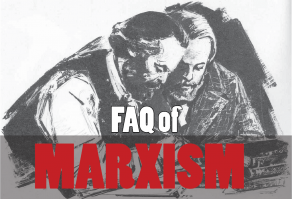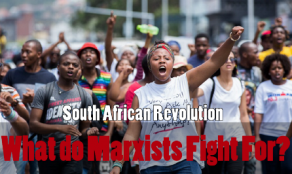Eighteen years since the end of Apartheid – and the dawn of ‘freedom and democracy’ - the brutal killings of 34 miners by the police in the Lonmin owned platinum mines at Marikana last Thursday has exposed the stark reality of the suffering and agony of the South African proletariat. This shooting is reminiscent of the harrowing Sharpeville massacre of sixty black protesters in 1960 by the then racist Apartheid regime.
The dispute was triggered after the Lonmin management refused a demand of wage increase by the miners from 400 rand ($484) to 12,500 rand. Instead workers were given ultimatums and threatened with sackings. Three thousand rock drill operators walked out on strike. There was a conflict on August 10 in which eight workers were killed by the police. In retaliation two officers were killed by the workers who had taken up clubs and machetes to defend themselves. They had had enough and were in a militant mood after their endurance had worn out. The lavish lifestyles and obscene salaries of their black and white bosses on the one hand and the destitute wages of the workers with soaring prices on the other exploded the stewing revulsion against the system.
Lonmin, a London based multinational corporation, is the third largest platinum mining conglomerate in the world. It was founded in 1909 and has been exploiting South African mineral resources for more than a century. In the year 2011 it had a turnover of US$1,992 million and yet these vulture capitalists are not prepared to give a paltry wage rise to the workers who for generations have been forced into drudgery for the accumulation of wealth for these parasites.
The South African regime in its callousness decided to teach these defiant workers a lesson to please their ‘investors’. On the morning of Thursday 16 August police contingents in armoured vehicles and on horses were sent in to crush the strike. The indiscriminate firing slaughtered 34 workers and scores were maimed. The police chief unashamedly described this heinous massacre as ‘self defence’. But this shooting has sparked an outrage not just in South Africa but around the world.
There was a valiant struggle of the South African masses against the vicious supremacist regime that was imposed by imperialism and treated the inhabitants of the land even worse than beasts of burden. This struggle was led by the African National Congress (ANC) and later on in collaboration with the South African Communist Party (SACP). However, the programme of the struggle went far beyond the elimination of apartheid as socialist class struggle was on top of the agenda up till the late 1980’s. However after the collapse of the Soviet Union, and in opposition to the wishes of the masses, the ANC and the SACP leaders retracted back into nationalism and bourgeois democracy. After the capitulation of the ANC leaders to this dictatorship of capitalism a negotiated settlement was reached with the Botha regime under the dictats of imperialism through which the Apartheid was formally ended and an ANC government was installed with Nelson Mandela as the new president. This was hailed as a great victory for democracy and freedom by all and sundry. Then US president Bill Clinton even visited the Robben Island prison where Mandela was incarcerated.
The leadership of the ANC has reaped huge benefits and privileges with their lavish lifestyles and abundance of wealth. But the plight of the masses if anything has rapidly deteriorated. Such is the intensity of the crisis that the incumbent leader of the ANC and South Africa’s President, Jacob Zuma even had to confess the economic predicament of the masses when he said as late as June this year, “The structure of the Apartheid era economy has largely remained intact.” The World Bank describes South Africa as one of the most unequal societies in the world. Inequality has actually increased since the end of the segregated white rule in 1994.
More than twelve million South Africans live in slums without drinking water, sanitation and social services. The over wrought electrical grid, piling filth, xenophobic violence
Although the ANC is being discredited for its 18 years of misrule no alternative has yet arisen on the political horizon. But there are enormous pressures swirling from below that are casting the leadership in the dock. Malema’s expulsion was an expression of this ferment. But radical populism is not good enough. A scientific programme of socioeconomic transformation is the burning necessity of the movement to find a way-out. The crisis within the ANC is reflecting the extreme turmoil in society. Currents on the left including Marxists are on the rise. It is very likely that the next ANC congress in December will witness a rousing opposition challenging the leadership. and crime adds to the misery. Official unemployment rate is 36 percent and fifty percent of the population lives below the poverty line. According to UNICEF seven out of ten children live in homes that endure severe poverty. State violence against those who protest against these deprivations is a routine affair. Hence when the expelled leader of the ANC’s Youth League, Julius Malema, described the situation at the Marikana mines as a fight between the capitalists and the exploited workers he drew enormous applause from the striking miners. Although the Lonmin management has been forced to suspend plans for the of sacking thousands of workers the Marikana tragedy is not going to fade away from mass consciousness any time soon.
The Congress of South African Trade Unions (COSATU) leadership has played no less pernicious role than that of the ANC’s. The traumatic incident at Marikana could become a spark that can ignite a mass movement of the workers and youth that has been simmering with revolt. After the formal end of the Apartheid the old white elite in partnership with the new black ruling clique has intensified exploitation and deprivation. The change of colour of the ruling elite doesn’t change their scrounging character. Stormy events impend. Some are drawing parallels of the Marikana massacres with the events that ignited the Arab revolution. South Africa is a key country in Africa. Its proletariat and youth have marvellous and fearless revolutionary traditions. Flares of its revolutionary torch will inevitably illumine the black continent.


